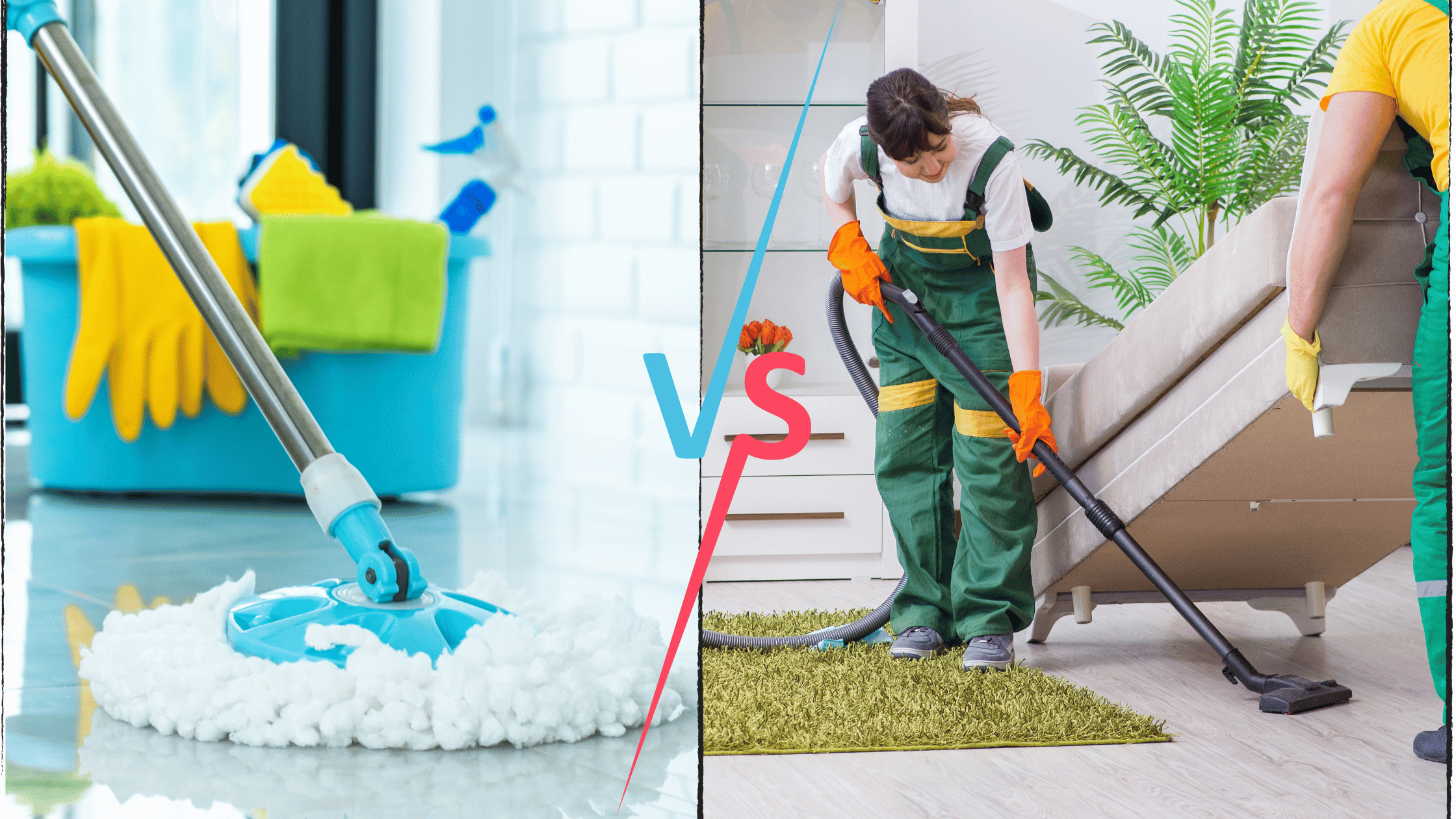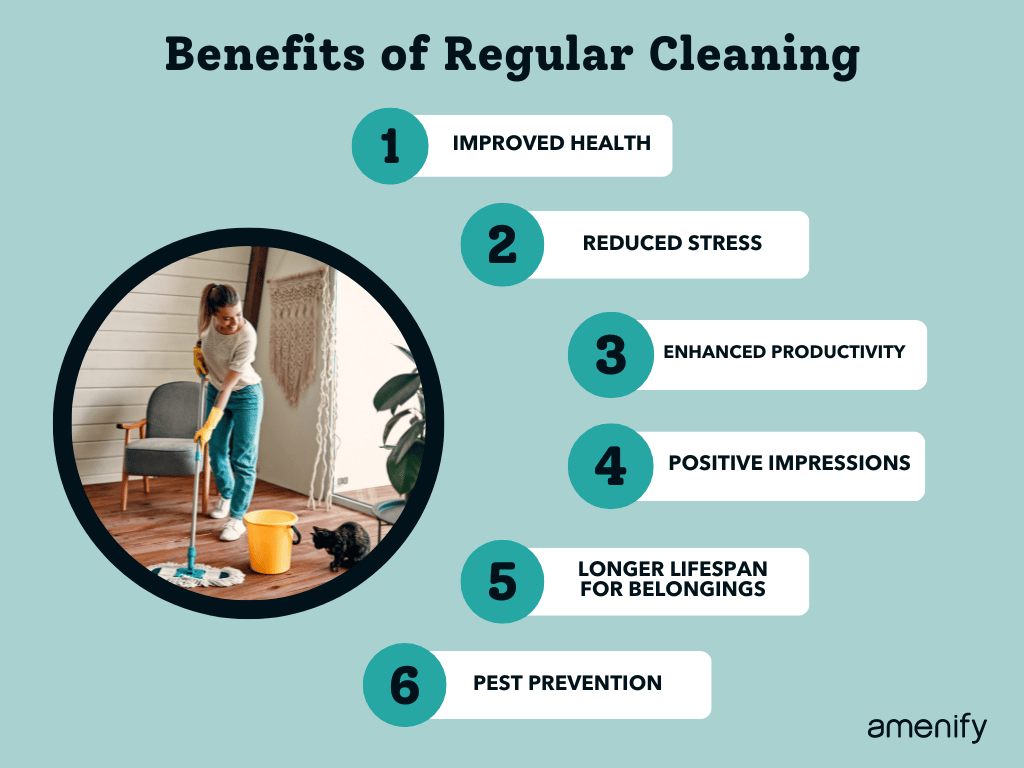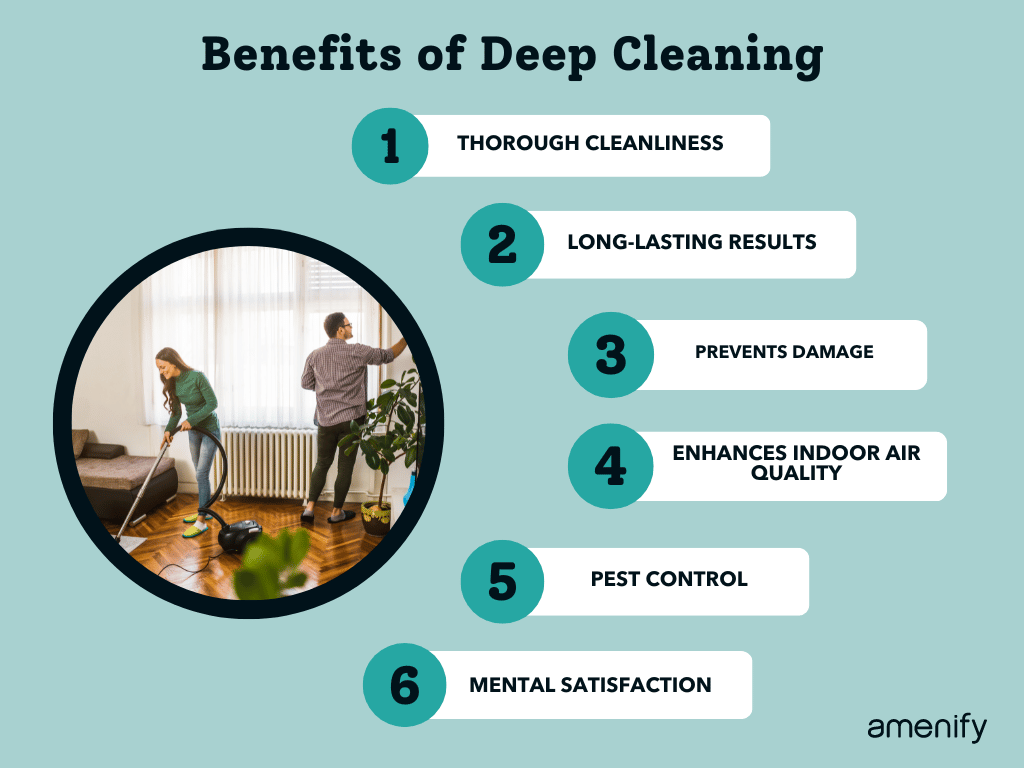Regular Cleaning vs Deep Cleaning. What’s the Difference?
Do you know? Indoor air pollutants are frequently 2 to 5 times more concentrated than outdoor levels, as stated by the United States Environmental Protection Agency (EPA). While you may regularly clean your kitchen, it's important to be aware that germs can actually survive for up to three days on moist surfaces - including those found in your kitchen and bathroom sinks.
Interesting Fact: The Asthma and Allergy Foundation of America notes that more than 50 million Americans experience various types of allergies each year.
Every home or office space necessitates a certain degree of cleanliness to maintain a healthy and comfortable environment. Over time, two distinct types of cleaning have come to the fore: regular cleaning and deep cleaning. Though they may seem synonymous to the untrained eye, there are indeed several nuanced differences between the two. Let's dive deep into these realms of cleanliness to understand what differentiates a regular cleaning routine from deep cleaning.
What is Regular Cleaning?
Regular cleaning is the day-to-day or week-to-week housekeeping that contributes to a tidy and functional living or working space. It's the fundamental layer of cleanliness that maintains an acceptable level of hygiene, comfort, and aesthetics in your home or office. It is the first line of defense against the build-up of dirt, dust, and clutter, keeping potential health risks at bay.
Regular cleaning chores are often those that immediately impact your sense of cleanliness and order. Now, let's explore the typical tasks that are part of regular cleaning.
Benefits of Regular Cleaning
Regular cleaning offers a range of advantages that contribute to a healthier and more pleasant living environment. Here are six benefits of keeping your surroundings clean:
Improved Health: Regular cleaning helps eliminate dust, allergens, and germs that can trigger allergies and respiratory issues, promoting better indoor air quality and overall well-being.
Reduced Stress: A clutter-free space can lead to reduced stress levels. Organized surroundings make it easier to find things, creating a sense of order and tranquility.
Enhanced Productivity: A clean and organized workspace fosters better focus and productivity. Clutter-free areas allow you to concentrate on tasks without distractions.
Longer Lifespan for Belongings: Regular cleaning and maintenance extend the lifespan of furniture, appliances, and other items, saving you money in the long run.
Positive Impressions: Clean spaces make positive impressions on guests and visitors. It reflects your attention to detail and creates a welcoming atmosphere.
Pest Prevention: Regular cleaning and proper sanitation deter pests like rodents and insects from taking up residence in your home, preventing potential health risks.
How to Clean your Home?
Regular cleaning involves dusting, vacuuming, mopping, and maintaining a general level of cleanliness. Think of it as an ongoing effort to keep your living or working space neat and sanitary. Here are the details on how to thoroughly clean your home:
Dusting Surfaces
For dusting surfaces, it's advisable to use furniture polish and a soft cloth for wooden items. Upholstery can be cleaned using a vacuum cleaner that has an appropriate attachment. When it comes to electronics, electrostatic wipes work well for cleaning screens and surfaces. For other items in the house like lamps, artwork, and decorative objects, regular dusting is key, and an extendable duster can be particularly useful for hard-to-reach areas.
Vacuuming and Mopping Floors
Vacuuming and mopping floors are essential parts of home maintenance. Carpets and rugs should be vacuumed using the right settings, and for deeper cleaning, steam cleaning is recommended. When cleaning hardwood or tile floors, sweep before mopping with a microfiber mop and the cleaner suitable for the surface. Excessive water should be avoided, especially on hardwood floors.
Kitchen Maintenance
Kitchen maintenance includes wiping down counters with an all-purpose cleaner suitable for the material, be it laminate or granite. Stainless steel appliances require a special cleaner to avoid streaks and smears. Regular sanitization of the sink is advised, and for deeper cleaning, a mixture of baking soda and vinegar can be used.
Cleaning Bathrooms
Bathroom cleaning involves using cleaners effective against soap scum and lime deposits for sinks and countertops. Toilet bowls need to be cleaned regularly, paying special attention to areas under the rim and around the edges. Shower tiles and grout benefit from strong cleaners, and using a daily spray-on cleaner can help prevent build-up.
Trash Management
Proper trash management includes emptying bins when they're full or starting to smell. Regular sanitization helps prevent bacterial growth, and segregating waste into recyclables, compostable, and general waste is recommended.
Laundry
Laundry procedures should involve sorting clothes by color and fabric type, using the appropriate detergent and washing settings. Clothes should be hung to dry where possible or dried in a machine with suitable settings. Once dry, they should be folded neatly and put away.
Regular cleaning, though it might seem repetitive, is essential to prevent the build-up of dust, dirt, and grime. It helps to maintain a pleasant atmosphere in your home or office, promoting health and well-being.
Features of Regular Cleaning
Time-Consuming: Regular cleaning requires a certain commitment of time and effort. With our increasingly busy lives, finding time every day or week to clean can sometimes be a challenge.
Surface-Level Cleanliness: Regular cleaning often involves only surface cleaning. This can result in the buildup of dirt, grime, and dust in inaccessible areas, which may go unnoticed and contribute to long-term health concerns.
Repetitive and Monotonous: The repetitive nature of regular cleaning tasks can be monotonous. This can sometimes lead to negligence, especially when the cleaning tasks seem never-ending.
The Frequency of Regular Cleaning:
Regular cleaning, as the name suggests, is carried out regularly. The frequency at which you clean can differ based on various factors, including the size of your living area, the number of individuals residing with you, and your personal habits and lifestyle. However, it is generally recommended to clean on a daily or weekly basis.
For example, high-traffic areas or surfaces might require daily attention, while other tasks such as vacuuming or mopping might be performed weekly. Similarly, tasks like laundry might be done as needed, depending on the size of the household and the accumulation of dirty clothes.
What is Deep Cleaning?
Deep cleaning is an intensive, thorough process that focuses on the areas often overlooked in a regular cleaning routine. While regular cleaning helps maintain a neat and tidy space, it's not sufficient to reach the depths of dirt and grime that slowly build up over time. Deep cleaning is precisely what is needed in this situation. Deep cleaning ensures that every inch of your house gets the attention it deserves, from removing scale from bathroom tiles to dusting off hidden corners.
Benefits of Deep Cleaning your House
Regular cleaning is important for keeping our homes and offices tidy, but after thoroughly sanitizing and rejuvenating our spaces, deep cleaning is what we need.
Thorough Cleanliness: Deep cleaning addresses the stains that are beyond the reach of regular cleaning. It ensures every corner, under the heavy furniture or inside of kitchen appliances, is spotless, thus promoting a healthier living environment.
Long-Lasting Results: The results of a deep clean tend to last longer. Once your home undergoes a deep clean, it's easier to maintain with regular cleaning.
Prevents Damage: Deep cleaning can help to prevent corners caused by the build-up of debris. Deep cleaning eliminates limescale on your bathroom tiles and stubborn grease in your oven, effectively prolonging the lifespan of both surfaces and appliances.
Enhances Indoor Air Quality: By thoroughly removing accumulated dust, mold, and mildew, deep cleaning significantly uplifts the air quality within your home. This enhancement can be especially beneficial for those suffering from allergies or breathing problems.
Pest Control: Deep cleaning often involves cleaning areas of your home that are usually overlooked, such as under the sink or behind appliances. By cleaning these areas, you eliminate potential breeding grounds for pests.
Mental Satisfaction: There's a certain satisfaction and peace of mind that comes with knowing that your home has been spotless. This can make your living environment more relaxing and enjoyable.
How to Deep Clean Your Home?
Unlike regular cleaning, deep cleaning is not something you would do every day or week. It provides a more comprehensive solution, effectively tackling the issue of messy and dirty residues. that builds up over time and is typically hard to reach. It is extremely important to regularly schedule deep cleaning to thoroughly polish every corner of your home. Whether you choose to do it seasonally or twice a year, this meticulous cleaning will ensure that your space is left flawlessly clean and pristine. Deep cleaning process includes tasks like:
Washing Behind Appliances
Washing behind appliances like the oven and washing machine involves unplugging the appliance and moving it away from the wall. Vacuum the area and use a mixture of vinegar and water or a specialized degreaser for deep cleaning. Also, remember to check for any lost items behind the appliance.
Deep Scrubbing and Descaling Bathrooms
Deep scrubbing and descaling the bathroom requires focused attention. You can use specialized descaling products or lemon juice to tackle lime and mineral deposits on shower heads and taps. Don't forget to clean less obvious areas like the toilet tank and behind the toilet.
Deep Carpet Cleaning
Deep carpet cleaning involves more than regular vacuuming. Consider pre-treating stains with a specialized stain remover. For old or particularly stubborn stains, professional cleaning services may be needed. Adding a carpet freshener or a simple baking soda sprinkle can leave your carpets smelling fresh.
Cleaning Patio and Exterior Windows
Cleaning your patio and exterior windows is best done on a dry day. Long-handled brushes or a power washer can help in reaching hard-to-clean spots. Use appropriate cleaning agents for the specific materials your patio furniture is made of.
Dusting Vents and Fixtures
Regular dusting and cleaning of vents and fixtures are necessary for maintaining good air quality in your home. Soft-bristled paintbrushes can be useful for intricate fixtures and vents. It is recommended to perform this task on a quarterly basis.
Oven Cleaning
For cleaning inside your oven, if it has a self-cleaning feature, first remove all the racks. Otherwise, chemical oven cleaners or a mixture of baking soda and water can be used. Make sure the area is well-ventilated when using chemical cleaners.
Cleaning Under the Sink
Under-the-sink areas usually require a good wipe-down. Remove all items first and use an all-purpose cleaner. Depending on the material under your sink, different cleaning agents may be required. This is also a good opportunity to organize your cleaning supplies.
Window Panes
Cleaning window panes is more effective on an overcast day to prevent quick drying that leads to streaks. For detailing, a toothbrush or cotton swab can be used to clean corners and other small spaces.
Cleaning Blinds and Drapes
Blinds and drapes often accumulate dust and should not be overlooked. For wooden blinds, use a wood cleaner instead of water. Drapes could be either machine-washed, dry-cleaned, or steam cleaned, depending on the fabric type.
Deep cleaning your space gives it a fresh start, tackling hard-to-reach areas that are often overlooked during regular cleaning. It's like hitting the reset button on your home or office cleanliness.
What Should be the Frequency of Deep Cleaning Your Home?
Deep cleaning is usually not a weekly affair. Typically, it is recommended to do this type of task every six months or so. However, the exact frequency can vary depending on factors such as your living conditions, the number of people living with you, and personal preferences. Some people prefer to schedule a deep clean once every season, especially during spring or fall cleaning sprees.
Regular Cleaning vs Deep Cleaning
Here's a comparison table to better illustrate the differences between regular cleaning and deep cleaning your home.
| Regular Cleaning | Deep Cleaning | |
|---|---|---|
| Frequency | Daily/Weekly | Bi-annually or Quarterly |
| Focus Areas | Surface-level areas, visible dirt | Hard-to-reach areas, ingrained dirt |
| Tasks Include | Dusting, mopping, vacuuming | Carpet cleaning, appliance cleaning, descaling bathrooms |
| Time Required | Typically less time | Requires more time due to thoroughness |
| Purpose | Maintains cleanliness | Eliminates deep-seated dirt and grime |
| Effect on Indoor Air Quality | Moderate improvement | Significant improvement |
| Result | Keeps space tidy and neat | Comprehensive, thorough cleanliness |
When to Choose Regular Cleaning or Deep Cleaning?
Now that we've established the difference between regular cleaning and deep cleaning, the question is, when should each be employed?
Regular cleaning is, by default, a routine task. It should be done daily or weekly, depending on the size and usage of your space. Regular cleaning helps to keep your environment tidy and prevents the build-up of dust and dirt.
On the other hand, deep cleaning is typically scheduled less frequently due to its thoroughness. A good rule of thumb is to deep clean your space every six months. However, certain circumstances might call for more frequent deep cleans, such as:
Before moving into a new home
After a renovation or remodeling project
Preparing for an event at your home
If someone in the household has allergies
If you have pets, which can increase the accumulation of fur and dander.
How Amenify can Help in Deep Cleaning Your Home?
According to the American Cleaning Institute report, Americans spend an average of six hours per week cleaning. Professional cleaning service providers, like Amenify, not only save you time and money during the cleaning process, but they also guarantee a superior level of hygiene and comfort. The professional understand your cleaning needs and guarantee that your home or workspace remains a pristine, wholesome, and enjoyable environment. Don’t wait too much time to decide, provide your loved ones a clean and healthy home.
FAQs
-
Deep cleaning is an intensive cleaning process that targets hard-to-reach areas and tackles persistent grime and dirt. It goes beyond the surface, addressing corners and spaces often neglected during regular cleaning. This meticulous method ensures a healthier, thoroughly sanitized living environment.
-
A deep clean typically includes tasks like cleaning behind appliances, scrubbing grout, descaling bathrooms, and cleaning inside of windows. It also extends to areas often overlooked, such as under the sink, inside the oven, and along baseboards. Essentially, a deep clean targets every nook and cranny for a comprehensive cleanse.
-
Regular cleaning refers to the routine cleaning tasks carried out to maintain a neat and tidy living or working space. These tasks, typically performed daily or weekly, include dusting, vacuuming, sweeping, and mopping. Regular cleaning ensures a clean and pleasant environment by managing everyday dirt and clutter.
-
A regular clean focuses on surface-level cleaning and routine tasks, like dusting and vacuuming, to keep spaces tidy on a day-to-day basis. In contrast, a deep clean is a thorough and detailed cleaning process that addresses hard-to-reach areas, accumulated grime, and persistent dirt, offering a comprehensive level of cleanliness beyond the scope of a regular clean.




